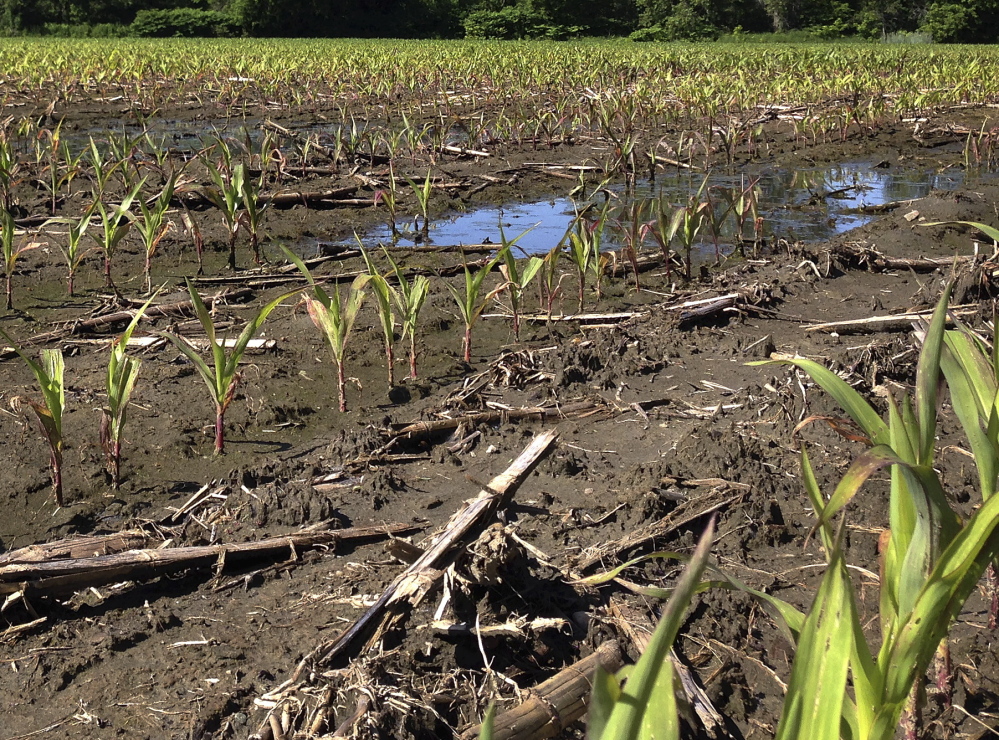MONTPELIER, Vt. — Farmers welcomed the rain after a dry spring but an abundance of it in June has saturated some low-lying crops, made fields too muddy for farm machinery and delayed the crucial first cutting of hay for livestock in some parts of northern New England.
Now they’re hoping a bout of rain-free days will dry out crops and fields that are too muddy for farm equipment to get to.
“It’s preventing us from planting. We have some fields that we just can’t get to. It’s just so wet. Any of our machinery it’s not equipped for so much mud, plus you can’t plant when it’s that wet,” said Melissa Mazza of Sam Mazza’s Farm Market in Colchester last week. “But we’re optimistic. The weather is supposed to turn around.”
The farm, which grows corn, pumpkins, hay, strawberries and other crops, was hoping for a bumper crop of strawberries but so far only has gotten about 40 percent of it, Mazza said. They need to plant more corn, and possibly more pumpkins after losing some to the rain in low-lying fields.
But conditions of crops and fields vary around the region depending on the topography, soils and amount of rain. Hartshorn’s Farm Stand in Waitsfield had a remarkable strawberry season, despite all the rain, said Amy Todisco, partner of owner Dave Hartshorn.
“I think our trick was just making sure that we took out any berries that were getting damaged so that no mold or slug infestation took over,” she said.
Farmers who grow hay for cows or other livestock typically do the season’s first cutting in early June. This year, Ken Hazinga, a grain farmer in Shoreham, doesn’t expect to be able to do that until next week, which means the hay is losing its nutritional value.
“There hasn’t been enough days in a row to dry it,” he said.
Last year was a bad year for hay so many farmers had to spend a lot of time and money finding hay at the end of the winter into spring, said Andrea Stander, executive director of farm advocacy group Rural Vermont.
In Maine, Jim Christensen also was late cutting hay on 500 acres in Durham. He began Wednesday with the first stretch of sunny weather, saying he needs three consecutive sunny days to allow the hay to dry out before being baled.
“So far it has been frustrating,” he said. “It’s nice weather but you get rainy days almost every other day.”
The rain has helped boost the hay yield at Hidden Trail Farm in West Springfield, New Hampshire, after a dry spring but “it’s still not up to snuff,” said Brian Patten. The farm’s hay yield was down about 50 percent a month ago and is now up to 75 percent.
“Everything we do falls around Mother Nature,” he said. “She’s got control of us. We’ve got no control over her.”
He plans to produce 6,000 to 8,000 bales of hay – if the weather cooperates.
For the blueberry industry, the rain was a mixed bag. Wild blueberry growers needed rain after a dry spring, but the timing of the rain and cooler weather prevented maximum pollination, potentially reducing the crop’s size, said David Yarborough, blueberry specialist at University of Maine cooperative extension.
The state imports in excess of 80,000 hives to pollinate the blueberry crop.
“The second you get rain, the bees go to the hives,” said William Hiss, president of the Androscoggin Beekeepers Club. “It would be the equivalent of hitting them with bowling balls.”
Send questions/comments to the editors.



Success. Please wait for the page to reload. If the page does not reload within 5 seconds, please refresh the page.
Enter your email and password to access comments.
Hi, to comment on stories you must . This profile is in addition to your subscription and website login.
Already have a commenting profile? .
Invalid username/password.
Please check your email to confirm and complete your registration.
Only subscribers are eligible to post comments. Please subscribe or login first for digital access. Here’s why.
Use the form below to reset your password. When you've submitted your account email, we will send an email with a reset code.